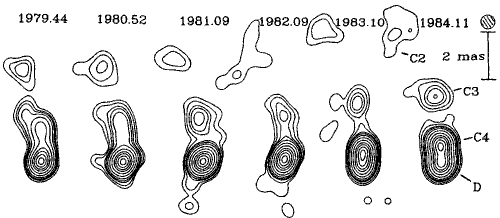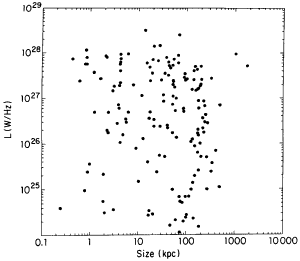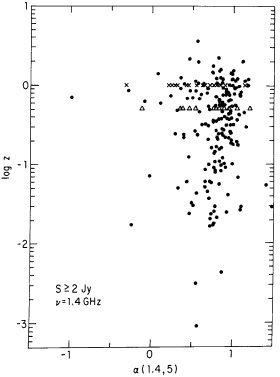QUASAR JET EXCEEDS 7 TIMES THE SPEED OF LIGHT
 |
| Animation of a series of radio images of 3C 345 at 10.7 GHz over the span of 5 years,
if the object was really extragalactic at 1700 MegaParsecs as most cosmologists
claim, its jets would be exceeding 7 times the speed of light !
(courtesy John Biretta/Space Telecope Science Institute) |
Varshni (1974)
has shown that quasar redshift is merely an empty number
without physical significance,
quasars are stars
within the galaxy. However, despite the
overwhelming amount
of contradictory data, the astronomical
community still persists in assuming that the redshift is a valid distance indicator
from which they incorrectly deduce that quasars are extra-galactic.
The gross
overestimation of quasar distance
has led to spurious paradoxical properties such as
superluminal motion,
one of four paradoxes of
Kellermann (1972),
which we now discuss:
Kellermann's Paradoxes |
Either |
Or |
| The density of radio sources depends on red shift in just such a way to
cancel the geometrical effects and the effect of the red shift. |
The Effect of the red shift on the observed fluxes for most of the
observed sources is negligibly small. |
| The intrinsic spectral-index distribution depends on red shift in
just such a way to cancel the effect of the red shift. |
The effect of the red shift on the spectra for most of the observed
sources is negligibly small. |
| The linear dimensions of radio sources depend on red shift in just such a way
to cancel the geometrical effects of the red shift. |
The geometric effect of the red shift on apparent size is negligibly small. |
| The intrinsic intensity of the two components of 3C 279 differ by just
the right amount to cancel the effect of the Doppler shifts. |
The distance of 3C 279 is much closer than indicated by the red shift and
the motion is actually non-relativistic. |
The paragraphs offset from the margin and bulleted are direct quotes from
Kellermann (1972),
the remaining text is the reviewers comments:
In the context of the plasma laser star theory we have shown that quasar
red shift is a number without physical significance. Kellermann (1972)
a highly respected radio astronomer at the National Radio Astronomy
Observatory (NRAO) has corroborated these findings based on observations in
the radio portion of the electromagnetic spectrum. He stated these paradoxes
succinctly in Table I.
The first and second paradoxes were discussed in
Varshni (1979);
the redshift obtained from optical quasar spectra has absolutely no correlation
with apparent magnitude.
The third paradox was discussed in
Varshni (1976a);
the largest angular size-redshift diagram for quasars is shown to be a
consequence of the distribution of their redshifts and has no intrinsic
physical significance.
The fourth paradox was discussed in
Varshni (1982).
- Today, modern radio telescopes can observe sources more than one million
times weaker than Cygnus A. If these sources have the same absolute
luminosity as Cygnus, then they are expected to be 100 to 1000 times
more distant, and far beyond the limits of even the largest optical
telescope.
We must be very careful when comparing the absolute luminosity
of the various radio sources. The distance to objects estimated using
the redshift criterion is irrelevant. The redshift has often been used to identify
objects as galaxies when no other valid criterion exited, since redshift is
meaningless, this classification scheme is obsolete; many galactic objects
are mistaken for galaxies in this way, such as
Cygnus-A.
One mistake in distance estimation such as this or in the case of the very first
quasars (Schmidt, 1965) creates paradoxical properties, that multiply in
number as observational techniques improve over the years.
- So, while we radio astronomers may claim to be able to see further out in
the universe than anyone, unfortunately we don't know 'where' we are
looking, and we don't known 'what' we are looking at.
Therefore radio data cannot be used as evidence against the plasma laser star
theory.
- When the studies are confined to a complete sample of quasars, the results
are dominated by an apparent evolution of source density or luminosity
with distance (or epoch) (e.g. Schmidt 1968), and little is revealed about
the geometry of the universe.
The quasar redshift versus apparent magnitude plot is a scatter diagram;
no physically meaningful inferences could be made from this relationship,
except of course that the redshift is a just number without significance.
- The evidence for evolution thus depends entirely on the acceptance
of the quasar red shift as cosmological...
since there are no sharp features in the radio spectra of galaxies and
quasars, there is no way to determine their distances from radio
measurements alone.
The optically obtained redshift is the only distance indicator for most
quasars, but we have shown it to be meaningless.
- In spite of the great effort which has gone into the determination of
red shifts, the lack of progress in using these data to distinguish
between the different cosmological models has been disappointing,
particularly in view of the large amount of observing time which has
been used on the largest optical telescopes.
This is exactly what we would expect from a number without any physical
significance.
- It is this effect which Hubble attempted, with only partial success, to
observe by means of optical-galaxy counts, and which in fact led him to
question the interpretation of the red shifts as a recession velocity,
25 years before the discovery of quasars (Hubble 1936a) !
The redshift of galaxies is also an empty number without physical
significance, Hubble himself published his doubts on this subject based
on his empirical observation not on theoretical mumbo jumbo.
- I do not, however, put much weight on arguments supporting the synchrotron
mechanism which are based on the observed existence of polarization, since
almost any nonthermal emission process will produce partially polarized
radiation.
Such as the non-thermal radiation from shocks produced by rapid plasma
ejections from plasma laser star atmospheres colliding with cooler slower
moving plasma, atoms or dust condensed from previous ejections.
- The problem is that if the quasars are at cosmological distances the rapid
intensity variations appear to require unacceptably large energies
(e.g. Pauliny-Toth and Kellermann 1966) ... The reason for this is that, if,
as has been commonly assumed, significant fluctuations in intensity cannot
occur in times less than the light travel time across the source without
'blurring' the observed variation, then the observations put a limit on
the linear dimensions typically of the order of one light year. If the
quasars are at cosmological distances, then this corresponds to angular
sizes well under 10^-3 arcsec and magnetic fields less than 10^-5 G.
In such weak fields, the energy in the form of relativistic particles
required to explain the observed radio emission is then typically greater
than 10^58 erg generated in one year or less. Even in these days when
violent events in quasars and the nuclei of galaxies are commonly
accepted, the thought of energy generation at the rate of 10^51 erg/sec
lasting one year or more seems too fantastic for most to accept.
For this reason, it was suggested that quasars were not as cosmological
distances ... The observations therefore suggest that the sources are
closer than indicated by their red shift
On this point, there can be no doubt.
- Also there is, of course, still considerable doubt among some about the
cosmological origin of the quasar redshift.
It is refreshing to see such a candid discussion on the assumptions behind
standard cosmology unlike more recent papers that implicitly assume that
quasars are extragalactic.
- As is outlined in the table, in each case it appears that unless there is
some close and subtle connection between the properties of the radio
sources and their red shift, or that the entire class of general relativistic
cosmologies is inappropriate to our particular universe, it is difficult
to reconcile the observed red shifts with the apparent lack of any other
distance indicator. It is indeed disappointing, and perhaps cause for
concern, that so far it has not been possible to detect the expected effect
of the red shift on the observed intensity, angular size, or spectra of
extragalactic radio sources.
Red shift has no physical meaning, we don't expect any correlation with
radio properties.
- If the large observed red shifts are of cosmological origin, then it
appears that the only way in which we can save our accepted models of the
universe is by introducing somewhat arbitrary systematic changes with
distance in the density or luminosity, in the spectra, and in the linear
dimensions of radio sources.
The question is, 'Are we drawing too many epicycles ?'
 |
Linear Size versus Luminosity
For 1.4 Ghz radio sources brighter that 2 jansky,
the distribution of linear size versus luminosity is a scatter
diagram
(Condon, 1991),
there is no correlation between these properties implying
that the distance determination method is faulty. |
| |
 |
Redshift versus Spectral Index
The distribution of redshift versus spectral index at 1.4 GHz is also a scatter diagram
(Condon, 1991),
a strong indication that the redshift is a number without physical
significance. |
- The counts of radio sources, in particular, appear to be as inconclusive
as the optical-galaxy counts from which Hubble concluded more that 30 years
ago that if the red shifts are interpreted as velocity shifts,
he comments :
 the (velocity-distance) relation departs from linearity by just about the
added correction for recession ... the necessary adjustments and
compensations suggest that the model may be a forced interpretation of
data , and, ... we may evidently choose between a curious small-scale
universe and new principles of physics'
the (velocity-distance) relation departs from linearity by just about the
added correction for recession ... the necessary adjustments and
compensations suggest that the model may be a forced interpretation of
data , and, ... we may evidently choose between a curious small-scale
universe and new principles of physics'
-Edwin P Hubble, 1936a
The new principles of physics is not really new, it is called the quantum
mechanics of stimulated emission postulated by
Einstein (1917).
Amplified spontaneous emission from a plasma with an inverted population is the
mechanism for the unusual strength of quasar lines.
- One can't help but wonder what choice Hubble would make today, but his
conclusion in 1936 that 'there is little excuse for the observer to weigh
possibilities, because in due course, the 200 inch reflector will
presumably furnish definitive tests'
How true ! This test has already been made by
Luyten (1969)
in his observations using the smaller yet no less venerable instrument
on Palomar mountain: The Oschin Schmidt. In Luyten's survey of 951 faint blue stars, no
less than
40 quasars
had been serendipidously included in the proper motion studies.
Many of these quasars show significant galactic proper motion, indicating that they
are hot stars within our own galaxy. Not coincidentally, one of the brightest
quasars in the sky,
TON 202,
has one of the largest proper motion, about equal to that of NGC 7293, the central
star of the Helix Nebula.
(N.B.: The Oschin Schmidt was used to carry out the original National
Geographic-Palomar Observatory Sky Survey (POSS), whose plates are still widely
used by the astronomical community)
REFERENCES
- Biretta also discovered that M 87 is also travelling at 6 times the speed of light
- Hubble,E.:
1936a, Proc.Nat.Acad.Sci. 22, 621.
- Condon,J.J.: 1991, in Galactic and Extragalactic Radio Astronomy, 2nd ed. p.641,
eds. Kellermann, K.I, Vershuur,G.L., Springer Verlag.
- Kellermann, K.I: 1972, Astron.J. 77, 531.
'Radio Galaxies, Quasars, and Cosmology'
- Kellermann,K.I., Owen,F.N.: 1988 in Galactic and Extragalactic Radio Astronomy,
Verschuur,G.L., Kellermann,K.I. (eds) p.563 (Springer, New York)
- Schmidt,A.: 1968, Astrophys.J. 151, 393.
- Pauliny-Toth,I.I.K., Kellermann,K.I.: 1966, Astrophys.J. 146, 634.
- Web link to POSS data and Minnesota Univ. Plate Scanning Project at NSSDC.
- ... if the quasars are much closer than indicated by their redshift,
then of course the linear velocities may be less than the speed of light.
Moreover, the apparent inverse Compton catastrophe implied by the rapid
flux density variations is then no longer a problem.
- Kellermann et al. (1988)
Return to the What's New Page.




 the (velocity-distance) relation departs from linearity by just about the
added correction for recession ... the necessary adjustments and
compensations suggest that the model may be a forced interpretation of
data , and, ... we may evidently choose between a curious small-scale
universe and new principles of physics'
the (velocity-distance) relation departs from linearity by just about the
added correction for recession ... the necessary adjustments and
compensations suggest that the model may be a forced interpretation of
data , and, ... we may evidently choose between a curious small-scale
universe and new principles of physics'